Pym enters a hollow Earth but returns safely to the US
As Poe writes in the final note, Pym returned to the US where he later died of a sudden but unspecified accident, which was covered by the media.
Pym states in the preface that he didn’t keep a journal during a large portion of the trip, so he had to write the events from memory. According to the editor, all the events reported in the book have actually happened to Pym.
The question is whether we should take Pym’s narration literally (and there are reasons to doubt that; see below). If we are to believe his story, then it is very likely that the openings Pym mentions near the cataract are the entrances to the interior of Earth, considering how acquainted Poe was with the concept of hollow Earth.
There are, indeed, a few descriptions in the novel that support this interpretation.
While navigating towards the south pole Pym notices very strange phenomena.
The temperature of the sea and air increasing further south they sail
OK, it is very obvious that the further south you sail, the colder the water should become right? The crew passes the Cape of Good Hope in South Africa and proceed southwards to explore unexplored Antartic regions. Pym relates that the water gets increasingly warmer the southern they sail, which is weird, since they are getting closer to the South Pole, so the water should be cooler.
At some point during their escape “the heat of the water still increased, and the hand could no longer be endured within it”. So the temperature of the water reached such a level that even putting the hand was out of question.
Also, note that Pym mentions that the temperature of the air became surprisingly milder and the weather even pleasant, which defies logic.
Why would water get warmer and the temperature of the air milder the closer they were to the chasm? Well, according to hollow Earth believers, if Earth is really hollow then the interior should be warmer.
One of the fiercest hollow Earth proponent, John Symmes, actually proposed that the region closest to the poles is actually warm. Perhaps, heat from the hollow Earth permeated the seas on the surface near the division between inner and outer Earth shells. Of course, for dramatic effect, Poe greatly exaggerates Pym’s description on how hot the water was.
Multi-coloured and milky white water
Near the Bennet’s Isle, Pym notes that the sea is “of an extraordinarily dark color”.
Continuing the journey, the water transformed into distinct veins of multiple colours. This is how Pym describes it: The water “was not colourless, nor was it of any one uniform colour […] the whole mass of liquid was made up of a number of distinct veins, each of a distinct hue; that these veins did not commingle; and that their cohesion was perfect in regard to their own particles among themselves, and imperfect in regard to neighboring veins”.
Pym attempts to blend the veins by cutting them across, but is utterly unsuccessful. Then he tries to cut along their edges, which segregates them even more. So no matter what he tried, he simply couldn’t mix the original state of the veins.
In the final chapter Pym again notes that there is another perceptible change in the colour of the sea. The colour changed yet once again and was “no longer transparent, but of a milky consistency and hue”.
So, the characteristics of the water changed the further south the Pym travelled:
1) the typical transparent colour (as we know it)
2) dark colour (around Bennet’s isle)
3) thick multi-coloured “veins” (in Tsalal)
4) milky consistency and hue (near the cataract)
This transformation from transparent to thickly white is interesting, although nothing I have read about hollow Earth theories suggest anything of the kind.
The Tsalalians seem to drink the multi-coloured water and, as Pym writes, it is “as perfectly limpid as any limestone water in existence”. Perhaps, the coloured water is a mere consequence of the interaction between the supernatural coming from the hollow Earth and the island. The water becomes purer the closer they get to the chasm: the perfect water being milky white.
In fact, there is another putative benefit of the natural resources found in Tsalal. Apparently, the scurvy grass cured disease among the crewmen: “[…] the scurvy grass proved of incalculable benefit in restoring those of our men who had shown symptoms of disease. In a very short time we had not a single person on the sick-list”.
Tsalal, being the island most connected to the hollow Earth, may be benefiting from the curative and medicinal properties of the advance civilisation purportedly dwelling inner Earth.
Vapour curtain
“A high range of light gray vapour appeared constantly in the southern horizon, flaring up occasionally in lofty streaks, now darting from east to west, now from west to east, and again presenting a level and uniform summit – in short, having all the wild variations of the Aurora Borealis. The average height of this vapour, as apparent from our station, was about twenty-five degrees”.
The mentioning of the Aurora Borealis is very interesting because when the original hollow Earth theory was proposed by Edmond Halley he explained the phenomenon as gases from the interior of the Earth finding their way up through holes on the surface of the Earth.
The vapour eventually rose so much that it created a kind of silent cataract covering the whole southern horizon and seemed to rise limitless in the sky.
There is no explanation why the vapour curtain formed, but it probably served as a barricade against unwelcome visitors.
Unusual fauna and flora
As soon as Jane Guy arrives in Antarctic waters the crew is welcomed by a series of strange animal sightings.
The description of the white mammal spotted just off the coast of Tsalal is very telling: “it was three feet in length and six inches in height, with four very short legs, the feet armed with long claws of a brilliant scarlet, and resembling coral in substance. The body was covered with a straight silky hair, perfectly white, The tail was peaked like that of a rat, and about a foot and half long. The head resembled a cat’s, with the exception of the ears – these were flapped like the ears of a dog. The teeth were of the same brilliant scarlet as the claws”.
Furthermore, Pym notes that “holes” in the curtain of vapour momentarily form, within which he is able to make out wide indistinct figures.
In addition, when they get closer to the cataract, Pym spots gigantic white birds flying just beyond the cataract emitting the “tekeli-li” sounds that are also voiced by the Tsalanians.

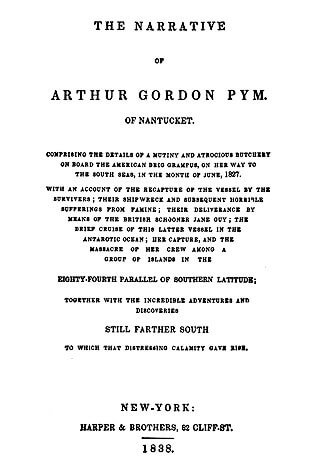
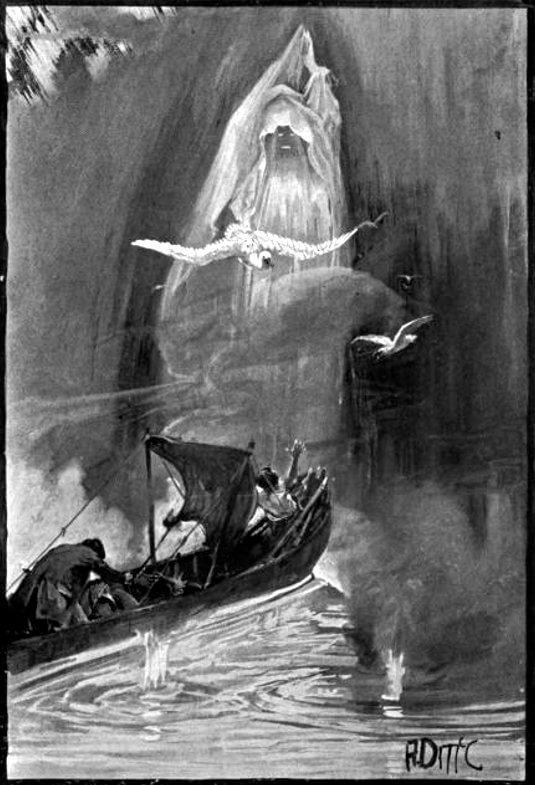
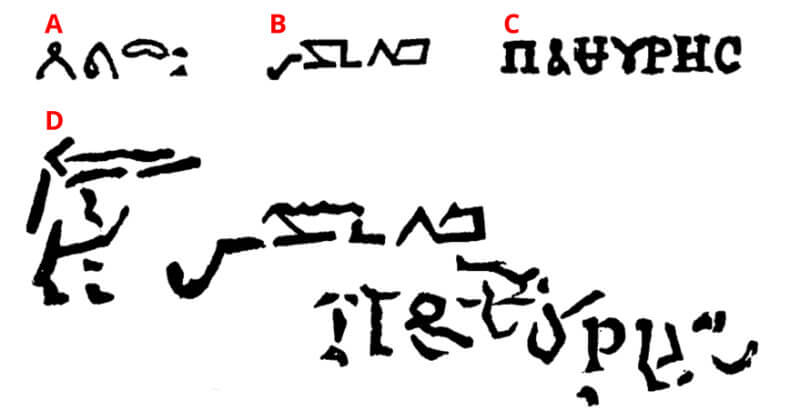
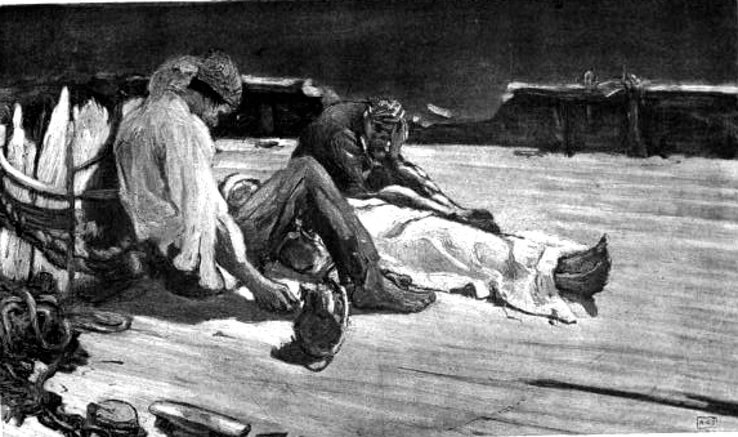
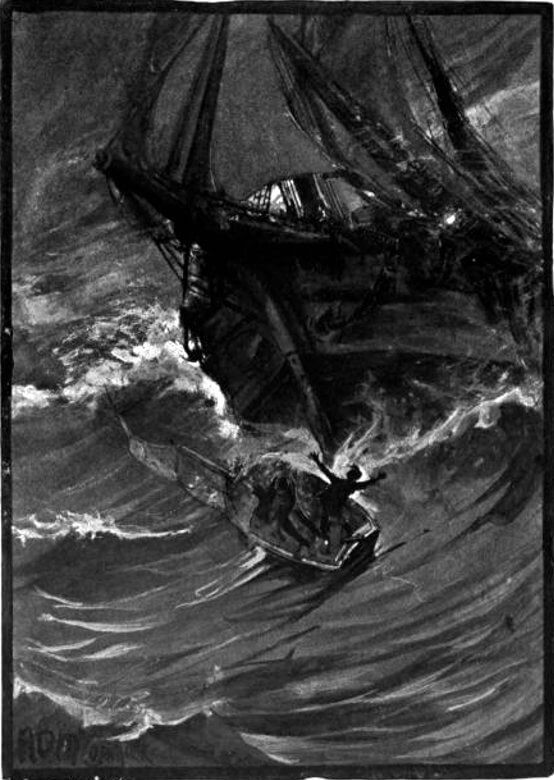
Leave a comment
Add Your Recommendations
Popular Tags